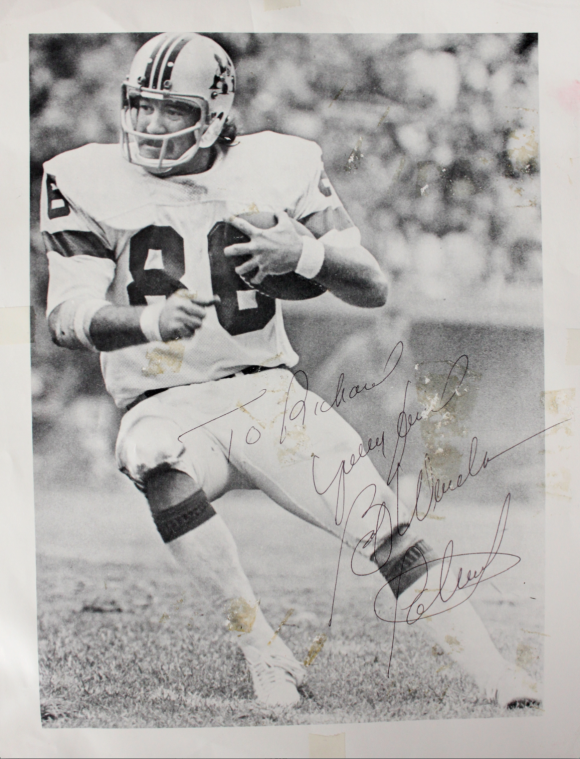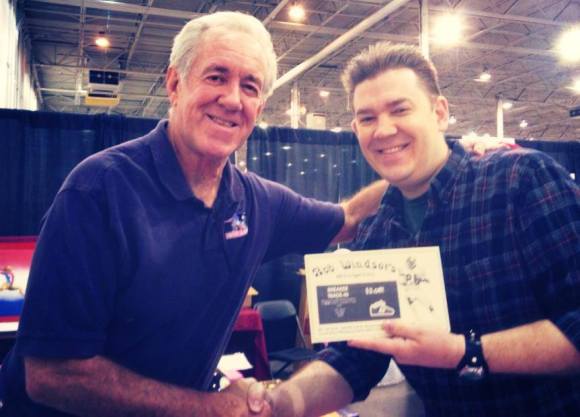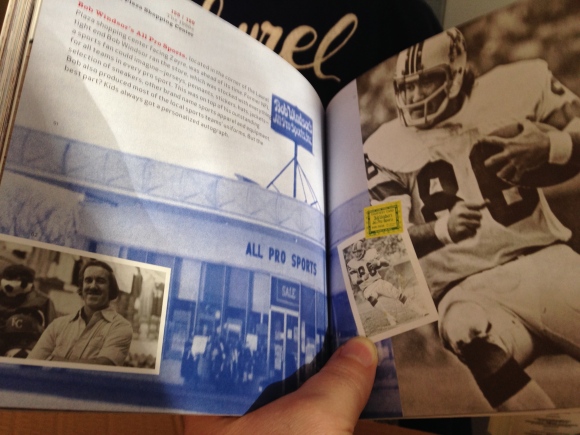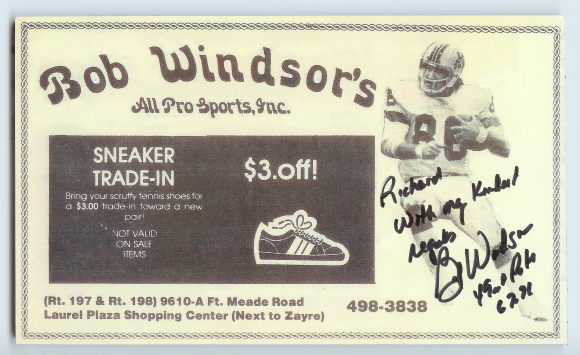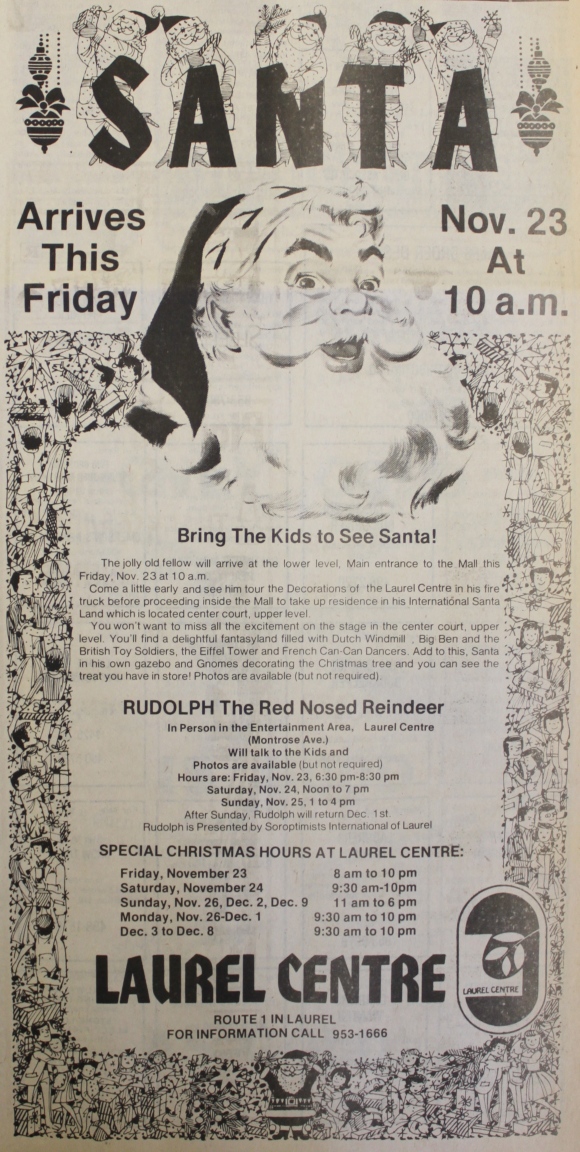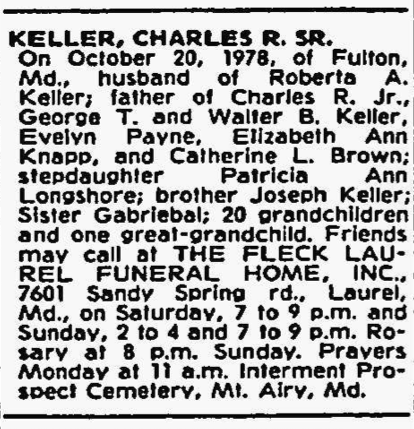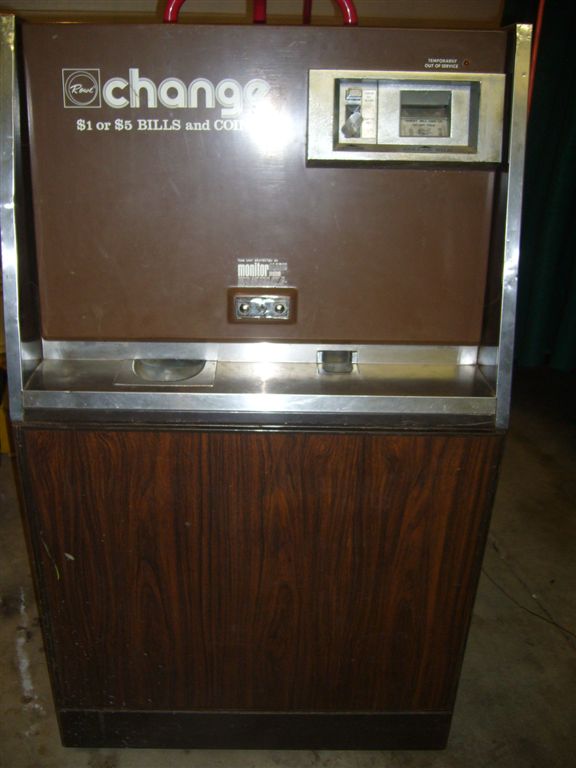
John Floyd II outside the Laurel Art Center in April, where he also went to photograph the closing of another Laurel icon.
Last month, I wrote about the plight of John Floyd II, the kind and gregarious Laurel native who’s contributed so many wonderful photos, artifacts, and historical data to share with Lost Laurel.
John, who has lived frugally in the same home for some 46 years—the home of his late stepdad, Harry Fyffe (of Laurel’s legendary Fyffe’s Service Center)—recently saw his home sold at the annual Prince George’s County Tax Auction in May, after falling behind on his 2011 property tax bill. Earning only approximately $10,000 last year from his eBay sales—his sole means of income—and having been saddled with numerous veterinary bills, he simply didn’t have the money. And the county’s tax laws are harsh, to say the least—there’s no partial payment or installment plan; it’s literally all or nothing. John was given until June 30th to come up with over $3,000 he owed. If he missed that deadline, the debt would balloon to over $7,000 when the 2012 tax bill is added on, along with the usual host of penalties and additional fees—and that imposing total would be due no later than July 31st. After that point, John’s redemption window would be slammed shut, and the new tax lien owners would be free to initiate foreclosure and eviction proceedings.
Not wishing to see that happen to anyone—let alone a dear friend whose photos inspired this very blog—I asked readers to join me in donating whatever they could to help John meet these deadlines and save his childhood home—and you did.
In only a few short days, I’m very happy to report that John had received just over $1,000 in donations, renewing his hopes of getting through this harrowing ordeal! In addition to the PayPal contributions and checks, folks even offered to drop off food and toys for the many cats John takes care of. Others helped by purchasing goods from his eBay store and referring friends. And although our little benefit didn’t raise the total amount, it was certainly an overwhelming outpouring of generosity from people who cared enough to help.
Fortunately, another generous soul was willing to loan John the remaining $2,400 he needed, and drove him to Upper Marlboro to make the payment just a day before the amount would have more than doubled. The immediate crisis averted, John can rest a little bit easier knowing that his home is once again safe—for now. But the experience has understandably rattled this genial chap who’s so hesitant to ask for or accept charity, and he’s already stressing about his next daunting challenge: repaying the loan by the end of the year, as well as the new property tax bill, which will be arriving any day now. More than anything, John wants to avoid a repeat performance.
And speaking of performances, if you read the original story, you’ll remember that John is a wonderfully talented musician who has played with countless ensembles over the years. Unfortunately, that career effectively ended with the demise of his last vehicle nearly a decade ago. This past May, he marched for the first time in years with the West Laurel Rag Tag Band in the Main Street Festival. I caught up with him this past Saturday, as he once again carried the giant antique Sousaphone in the 4th of July parade on what was easily the hottest one in years. Like everyone in this storied local band that made its first appearance back in 1983, the heat couldn’t temper John’s patriotic and civic spirits. If tough financial times couldn’t do it, neither could this heatwave!

John Floyd (back left carrying the Sousaphone) marches with the West Laurel Rag Tag Band past the now-closed Laurel Mall during the city’s 4th of July Parade. (Photos: Richard Friend)



John marching with the band on another hot day earlier this year during the Main Street Festival.
The 4th Street parade route is a familiar one for John; not just because he lives only a block away, but because he’s marched it since his Laurel High School band days in the early 1970s. That’s him as a young lad in the front, holding the trombone. Bandmaster Harvey Beavers is at left in, as John called it, “his ice cream suit”.

1975 LHS Homecoming Parade. (Kodak 110 Instamatic print by Phyllis R. Fyffe, Royal Blue Ltd. archives)

John at the 1973 LHS Homecoming, with Drum Major Jackie Jones. (Kodak 126 Instamatic print by Phyllis R. Fyffe, Royal Blue Ltd. archives)

John, Jackie, and Mr. B (sans ice cream suit) at the 2009 4th of July Parade. (Photo: Joe Stevick, Royal Blue Ltd. archives)
While we’re still on the topic of parades…
Thanks to John, this year I had the pleasure of meeting band director Bill Stevick and his wonderfully talented family after the big event, at their annual post-parade picnic! Believe it or not, 2013 will mark the 30th anniversary of the West Laurel Rag Tag Band. It’s membership has ebbed and flowed over these three decades, but the band has literally played on—consistently delighting Laurel twice a year: at the Main Street Festival and the 4th of July Parade. I hear there’s talk of possibly retiring the band after next year’s landmark anniversary, but let’s hope that’s not true! The folks who make up the Rag Tag Band are the heart of these homegrown events; and in many ways, the very heart of Laurel. Make sure you see them next year, and encourage them to keep this great tradition going!

West Laurel Ragtag Band Director Bill Stevick and me at the post-parade picnic. (Photos: John Floyd II)

Getting back to the topic at hand, I’ve got a number of Lost Laurel goodies to mail out to everyone who so generously donated to John Floyd’s cause. I’m in the process of sorting through the receipts that John has forwarded to me, and determining who gets what. (I volunteered an auction of sorts for those who were the first to donate specific milestone amounts, and you guys are cleaning me out!) 🙂 I may have to contact several of you in order to get a mailing address; but if you donated $25 or more, please feel free to already go ahead and email me that information (richard_friend@mac.com), or send it via direct message on the Lost Laurel Facebook page. There are some vintage Laurel posters and framed Marian Quinn prints going to some, but everyone who donated $25 or more will get a reproduction of the classic 1981 Delaney’s Irish Pizza Pub menu. I’ve just had a supply printed, and they’re ready to go!

I want to point out, however, that the fundraiser is by no means over. We’ve helped solve John’s immediate problem, but his financial situation is still extremely fragile, and I fear it will be for at least the coming year. On top of everything else, John’s computer is now on the fritz. It’s nearly 10 years old, and it’s the very lifeline to his modest income. And there’s yet another concern—his home is without air conditioning. John has lived without it for years without complaint, but as he’s wont to do, he’s more concerned about the ill effects this extraordinary heat is having on his cats. Counting every penny, (and knowing that he ultimately needs them both) he’s trying to decide which appliance he needs to save toward first.
Those of you who’ve already sent donations, I thank you again from the proverbial bottom of my heart. I hope you realize what a genuinely good deed you’ve done, and how your contribution didn’t merely go to some faceless charitable organization, (not that there’s anything wrong with that) but to a real human being—a good man who’s lived right here in Laurel for some 50 years; a man who’s fought fires with the Laurel Volunteer Fire Department, marches in our civic parades, and who knows and appreciates the town’s history—and residents—like few others.
If you’re able to spare even a bit, I assure you it’s going to a very good cause. I’ve got a bunch more Delaney’s menus available for anyone who donates $25 or more, but please remember that you don’t have to give in the double or triple digits to really help John out! Instead of buying that cup of coffee from Starbucks today, or downloading that new song or iPhone app, please consider sending even a dollar or two to John Floyd—literally every bit helps. There’s no deadline or minimum donation to worry about, and it only takes a minute to send funds securely direct to John’s PayPal account.
If I haven’t already made it abundantly clear, John is a one-of-a-kind friend who enjoys sharing his vast knowledge and resources of all things Laurel—the depth of which continues to surprise even me. His most recent gift to Lost Laurel is one that I never thought I’d see again, and is proving to be an unprecedented aide in documenting Laurel’s retail history in the 1980s—nearly two dozen Laurel telephone directories dating back to 1986! These include ads and listings for the mall and all of the shopping centers, making it easier to determine when various stores arrived in Laurel… and, of course, when they left.

Not only are these books a treasure trove of dates and locations, they hold rare ads for places that didn’t typically run ads in the Laurel Leader—or anywhere else. Places like Pipeline Surf Shop, which from 1989–90, shared space with the legendary Bikes Plus at 308 Compton Ave.

Yes, I realize it’s a bit odd to get excited about inheriting a shelf of obsolete phone books. But from a historian’s perspective, I assure you it’s quite awesome. The library doesn’t even have these anymore. Moreover, they’ll provide me with an ample supply of blog and Facebook updates in the weeks, months, and years to come.
Lastly—and this is important as it undoubtedly affects countless others in John’s situation—here’s a link to a WTOP article from earlier this week that details exactly what John is going through with this property tax ordeal. It’s a frightening concept that many homeowners probably aren’t even aware of—especially when one considers that people are literally losing their homes over as much as $400. Here’s an excerpt:
• If the taxes aren’t paid, the government auctions the lien to investors. Past investors include JPMorgan Chase, Bank of America and people who respond to Internet get-rich schemes, the report said. Homes typically are sold at steep discounts.
• For a limited time, the homeowner may buy back the home by paying to the investors the purchase price of the lien, plus interest, fees and other costs. That’s possible because investors haven’t bought the home itself _ they have purchased the tax lien, which gives them the right to seize the home later.
• If the owner fails to pay all the costs, investors can sell the home at a big profit compared with the cost of buying the tax lien.
The report said state governments should make it easier for homeowners to retake their homes after tax lien sales. It said they should limit the interest and penalties investors can charge and increase court oversight.
It also called on local governments to let people pay back taxes or fees to investors on an installment plan, and to increase notice to homeowners and make sure they understand their rights.
Tax lien sales differ from most foreclosures, which happen when people fall behind on mortgage payments. In many states, homes sold because of tax debts can be sold for only the amount of back taxes owed.
That means a $200,000 home might fetch only $1,200, the report said. In the process, homeowners can lose thousands of dollars in home equity that they have built up by making monthly payments.
Kudos to WTOP for shining a light on this, and hopefully enough voices will be heard to convince local governments to at least start making it easier for people—honest people like John who’ve fallen on tough times—to bring their payments up to date without the unnecessary threat of actually losing their homes.
Many thanks again to you all—please keep the good will coming, and let’s make sure our friend John is securely back on his feet once and for all!


